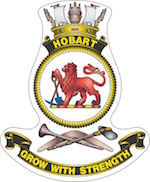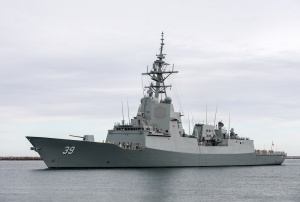HMAS Hobart (III)
| Class |
Hobart Class |
|---|---|
| Type | |
| Role |
|
| Pennant |
D39 |
| International Callsign |
VKLB |
| Motto |
Grow with Strength |
| Home Port | |
| Builder |
Air Warfare Destroyer Alliance |
| Laid Down |
6 September 2012 |
| Launched |
23 May 2015 |
| Launched by |
Mrs Nicola Hodgman |
| Commissioned |
23 September 2017 |
| Dimensions & Displacement | |
| Displacement | 7000 tonnes (full load) |
| Length | 146.7 metres |
| Beam | 18.6 metres |
| Draught | 7.2 metres |
| Performance | |
| Speed | 28+ knots (top speed) |
| Range | 4500 nautical miles (18 knots) |
| Complement | |
| Crew | Approx 180 |
| Propulsion | |
| Machinery |
|
| Armament | |
| Missiles |
|
| Guns | Mk 45 5-inch 62 Calibre Gun |
| Torpedoes | MU90 torpedo |
| Other Armament |
|
| Physical Countermeasures | NULKA Active Missile Decoy system |
| Radars |
|
| Sonars | Integrated Sonar System incorporating a Hull Mounted and towed array sonar |
| Combat Data Systems | Aegis (Baseline 7.1) |
| Helicopters | 1 x MH-60R Seahawk |
| Awards | |
| Inherited Battle Honours | |
| Resources | |
| News Articles | |
| Image Gallery | |

HMAS Hobart (III) was the first of three ships of the Hobart Class guided missile destroyers. Ships of the same class are HMAS Brisbane (III) and HMAS Sydney (V). The keel of Hobart was laid down on 6 September 2012 and the ship was launched on 23 May 2015. HMAS Hobart (III) commissioned on 23 September 2017 at Fleet Base East, Sydney.
Hobart is based on the Navantia designed F100 frigate and is coupled it with the Aegis Combat System. Hobart was constructed in Australia by the Air Warfare Destroyer Alliance.
Hobart provides air defence for accompanying ships in addition to land forces and infrastructure in coastal areas, and for self-protection against missiles and aircraft. The Aegis Combat System incorporating the state-of-the-art phased array radar, AN/SPY 1D(V), in combination with the SM-2 missile, provides Navy with an advanced air defence system capable of engaging enemy aircraft and missiles at ranges in excess of 150km.
Hobart carries a helicopter for surveillance and response to support key warfare areas. The surface warfare function includes long range anti-ship missiles and a naval gun capable of firing extended range munitions in support of land forces. The ship was the recipient of the 2022 Otranto Shield for the fleet unit that achieves the highest standard in electronic warfare.
Hobart conducts undersea warfare and is equipped with modern sonar systems, decoys, surface-launched torpedoes and an array of effective close-in defensive weapons.
These capabilities ensure that the Hobart Class guided missile destroyers have the layered defensive and offensive capability required to counter conventional and asymmetric threats.








